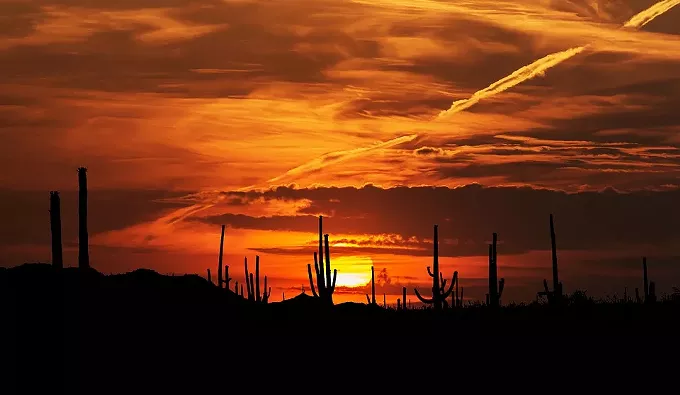
Few places in the world are quite like the Sonoran Desert, but according to the latest Intergovernmental Panel on Climate Change report, it might not be so unique in the coming years. The report’s forecast: Increased temperatures and drought pose a risk to every continent, including to roughly 3.5 billion people who live in areas that are highly vulnerable to climate change.
The IPCC report, released every six years, is a major international collaboration of hundreds of scientists. The reports examine the impacts, mitigation strategies and physical evidence of climate change in regions across the world. Two faculty members from the University of Arizona worked on the sixth annual report, released in February 2022, to assess the “vulnerability of socio-economic and natural systems to climate change.”
Carolyn Enquist, an adjunct faculty member with the UA’s School of Natural Resources and the Environment, is a lead author for the North America chapter of the report. Her work focuses on climate change’s impact on ecosystems and adaptation. Enquist said the goal of the report is not to conduct new research, but to provide an update and expert assessment of new information available since the last report.
“In terms of impact, our work focused on the rapid transformation of ecosystems. We’re seeing die-back and loss of regeneration in some places, like forests. What has really accelerated are these large, high-severity wildfires that have accelerated the transformation of ecosystems that were already underway,” Enquist said. “Last report, we saw numerous mortality events in our forests linked to drought stress, pests and pathogens overwhelming species’ innate capacity to adapt. And this time, we’re seeing that, with these wildfires, particularly in the Western U.S. and Western Canada.”
The report states with high confidence that in the Sonoran Desert, there will be further reduced vegetation and rainfall alongside increased temperatures and wildfires. For instance, Enquist said 2020’s Bighorn Fire was an example of these dangerous changes coming together. The Bighorn Fire burned more than 100,000 acres across the Catalina Mountains, fueled by drought, invasive grasses and build-up of fuels from fire suppression.
“It’s really unprecedented in some ways. These extreme fires are not what we’re prepared to fight, so it puts a lot of lives, property and ecosystems at risk,” Enquist said. “So you have this vicious circle that we’re seeing now, with multiple synergistic events that really challenge our ability to adapt effectively. So we’re looking at adaptation in conjunction with mitigation. We need the two, because we can only adapt so much to climate change that is already in the system. There’s this multi-pronged approach we need.”
The report also states that climate change impacts and risks are becoming increasingly complex and more difficult to manage. Multiple climate hazards will occur simultaneously, and multiple risks will interact, resulting in compounding overall risk and risks cascading across sectors and regions.
The 3,000+ page report discusses much more than the blunt facts of increased temperatures and environmental stress. Chapters also cover the changing culture around climate action, the inequality of climate change impacts, developing human systems for a more resilient climate and more.
“What we really found was that the federal government started to step back, and the cities have really stepped up. There’s lots of action and activity in cities across North America, leading the charge on climate adaptation in recent years,” Enquist said. “This report also finally acknowledged the contribution of Indigenous knowledge to climate adaptation, and what we as Western scientists can learn and share with our Indigenous partners… We have such a rich cultural heritage in the Southwest with Indigenous knowledge, and we need to bring all our tools, not only for survival, but to thrive.”
UA Regents Professor in the School of Geography, Development and Environment Diana Liverman served as a review editor for the report’s final chapter on climate resilience development.
“This report confirms that even at the 1.1 degrees Celsius (2 degrees Fahrenheit) global warming already observed, we are seeing dangerous impacts on lives and ecosystems, with increasing losses of life and species projected if we continue to heat the planet,” Liverman said in a prepared statement. “These impacts are exacerbated by poverty, land use change and oppressions that make many people and places more vulnerable.”
Anthropogenic climate change remains a needlessly political topic in the face of evidence. According to the World Meteorological Organization, the warmest six years on record have all been since 2015, with 2016, 2019 and 2020 being the top three. NASA, the American Chemical Society, the American Medical Association, the Geological Society of America and many more agree that “human activities are the primary cause of the observed climate-warming trend over the past century.”
“The jury is no longer out on the human role in climate change,” Enquist said. “Our conclusion was that we need all hands on deck and we need to be moving from an incremental approach to adaptation, to something that looks more transitional, that we can do faster and more efficiently. Individuals play a role, but governments absolutely do. People do have power to affect what’s going on around them. Numbers can make a difference. We should all be working together as North Americans and bringing different things to the table. No one entity can do it alone.”

